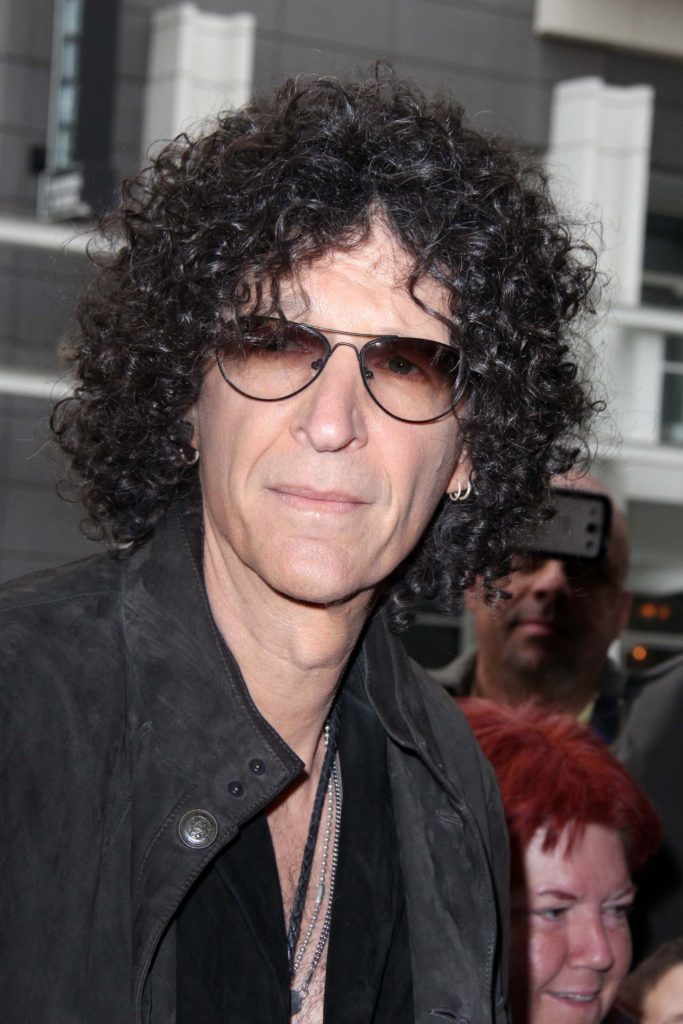
“Best of JacoBLOG continues with one of my favorite posts of 2021. The Howard Stern Era of commercial radio seems like a lifetime ago. In fact, many of today’s radio “veterans” are too young to remember it.
But during Howard’s amazing run on the FM airwaves – mostly on Rock and Classic Rock stations – there was no shortage of buzz. Howard was controversial, current, relevant, and fearless. And it made for what we call a very “cume urgent” show. You had to listen to be part of the conversation at work or around the dinner table.
As programmers, managers, and owners learned, however, was how the rest of the radio station fared was always a question mark. To what degree could stations hold onto Howard’s vast audience during middays was a central question. And how much a station’s brand revolved around their syndicated morning show out of WXRK, New York?
Howard laid much groundwork for how consumers listen to the radio. His dominance in the 90s and 00s foreshadowed the growth of personality radio on music stations. As today’s post reminds us, personalities continue to be critically important to a station’s health. And yet, the contradiction is how many have lost their jobs these past several years during budget cuts, layoffs, furloughs, and so-called reductions in force.
Perhaps the relationship between sustainable winning radio and the personalities who form engagement and audience relationships will become clearer in the new year. The ratings, the research, and common sense tell us they are the difference between local radio that matters and 250 song playlists interrupted with 20 commercials an hour. – FJ
April 13, 2021
In what seems like a lifetime ago, Howard Stern was tearing rock radio up, igniting morning drive in markets as diverse as Washington, D.C., Los Angeles, and Syracuse, NY.
In the late ’80s, Howard, along with Robin, Jackie, Fred, and Gary lit up the commercial radio airwaves, causing great consternation for the FCC, as well as station owners – whether they were competing against Stern or had him on their stations.
The reasons for Stern affiliates to be uncomfortable were several. They were concerned Howard’s antics would instigate sizable fines, as well as land them on “Do not buy” agency lists. And then there was the issue of Stern’s bonuses. Super agent Don Buchwald easily negotiated whopping performance incentives the show often blew through. If their sales were flagging, paying a six-figure bonus could be debilitating.
I remember working in a market that was ripe for Stern’s antics. The show was an instant hit, and our Arbitron monthlies were pointing up. After two strong months, I was talking with one of the owners about how well Stern was doing, and he confided in me he was praying for a bad third month. I asked him why in the world he was betting against his own station, and he told me flat-out Stern’s bonus would be debilitating to the station because of sales issues.
It was also at that time it started becoming obvious to me that researching a Stern station could be problematic at best, and deceiving at worst. When you asked consumers for their favorite station – a standard question in every perceptual study – if they chose WXRK or WYSP or WNCX, you were left with confusing information.
Were they choosing the station for Stern, the music, or both?

So, that became the required follow-up question that got added to every research study. It became known as “the Fred Jacobs memorial question.” (I actually preferred it being called “the Fred Jacobs honorary question” for obvious reasons).
And it worked. It clearly illustrated whether the music and Stern had any compatibility. And it also informed us about whether the music and/or local personalities were contributing in a significant way to the station’s success. I have added it to countless other perceptual studies, especially in circumstances where the morning show is a high performer. But even when a morning show is struggling or middling, it’s a great way to chart a brand’s course.
It tracks nicely over time. If you get an “annual physical” – a perceptual study – you can watch those trendlines. When Stern’s appeal reached a certain level, we knew we really didn’t have a music format or even a radio station. We had a highly popular morning show.
And when Stern left his terrestrial roots back in 2006, it left many of his former affiliates with a dilemma they could not overcome.
![]() So lately, I’ve been thinking a lot about that question, and its relevance to broadcast radio as it attempts to get past the pandemic.
So lately, I’ve been thinking a lot about that question, and its relevance to broadcast radio as it attempts to get past the pandemic.
To what degree are listeners tuning in for radio’s personalities, hosts, and shows? And in a world where Spotify, Apple, Amazon, and SiriusXM are providing music services, how is local radio competing in that highly charged subscription environment?
That’s why our Techsurvey 2021 results have been especially valuable this year. Last year’s study was fielded in January/February 2020 – just before the pandemic and the subsequent lockdown rocked our worlds. Our new study clearly reveals how habits and priorities have changed – and what they mean to radio broadcasters as we enter (hopefully) the “recovery phase” of COVID.
My favorite chart in Techsurvey attempts to answer the question, “Why AM/FM radio?” We give respondents a long list of potential reasons why they opt for broadcast radio (over other options) – and we ask them to identify the main driver for choosing a regular radio station.
Often when I show this chart, I focus on the “emotional underpinnings” of radio’s appeal – qualities like companionship, mood elevation, or escape. But on the version below, I’ve highlighted the radio fans who point to music as a main factor for listening to broadcast radio versus those who point to personalities, shows, and hosts:
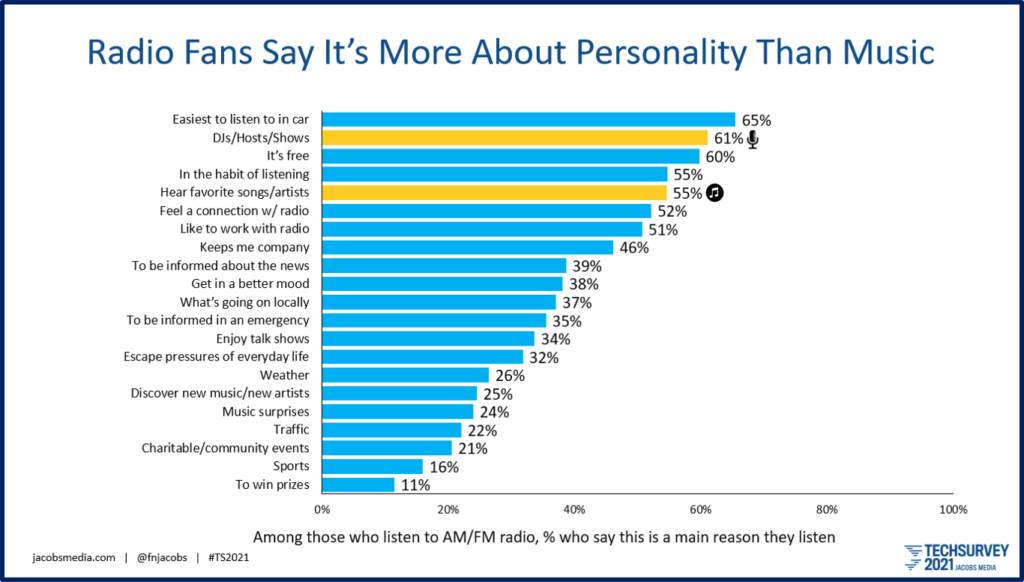
Like most research findings, there’s perspective to be gained in looking at data points over time. And fortunately, we’ve been asking these same questions over many years.
In comparing those who say music is a main driver in listening to AM/FM radio versus those who say personalities are part of the secret sauce, an unmistakable trend has emerged:
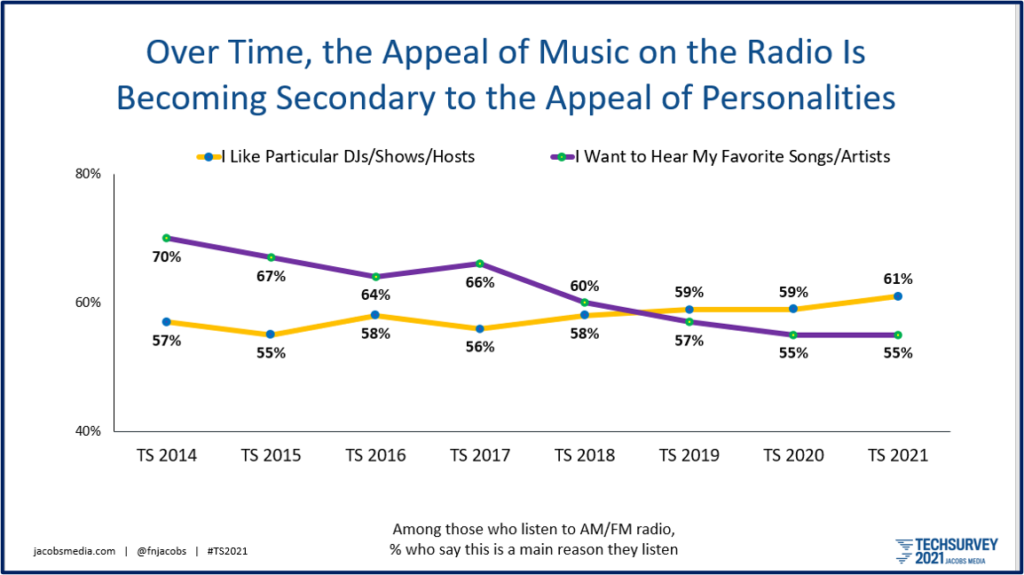
Now many variables could be impacting these results, especially a growing presence of fans of spoken word formats in Techsurvey. That said, however, two-thirds of fans of CHR, Urban AC, and Rock stations choose DJs, hosts, and shows as main drivers of broadcast radio.
And in the big picture, that makes a great deal of sense. Music has become commoditized and ubiquitous, available on umpteen streaming services, as well as on satellite radio, your cable or dish system, and your Bluetooth speaker system. It seems like in recent years, seemingly everyone has become a music radio programmer.
But it’s personalities that have become highly proprietary. They are the difference-makers for so many radio stations. And they’re the reason why more and more companies seek strong, habit-forming personalities, shows, and hosts in dayparts outside of morning drive. It’s also why syndicated talent has become so important in recent years. Anybody can duplicate your music, but its the people behind the mic that are your “secret sauce.”
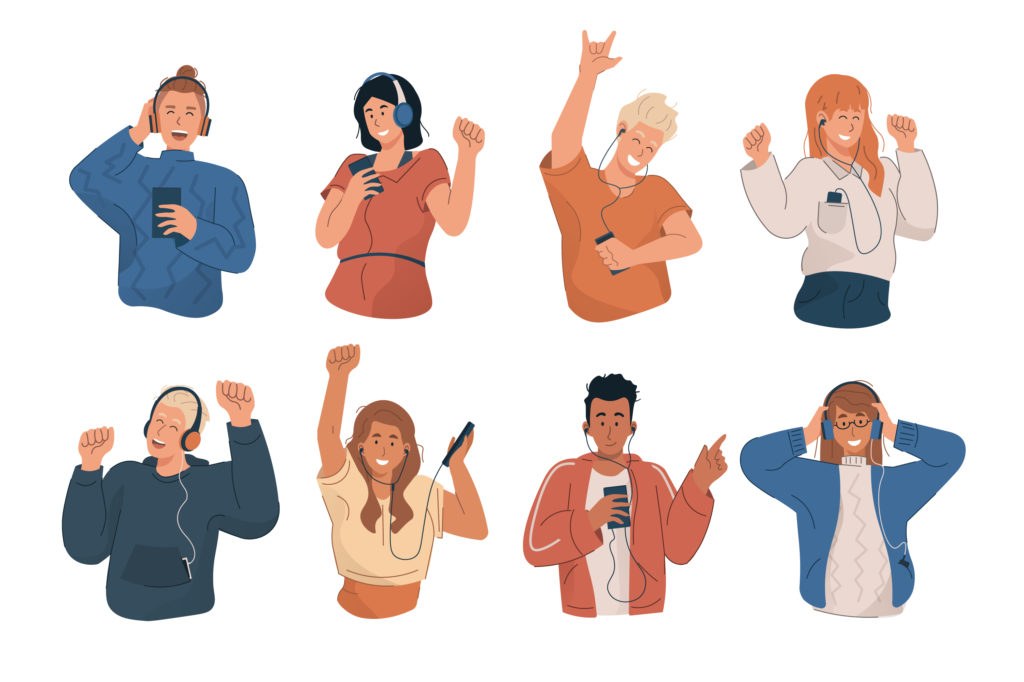
So, if that’s what the data and our brains are telling us, why are so many radio stations doing research like it’s 1989?
If we could see the research spending data across the broadcast radio industry, we’d discover just how much much more money, resources, and efforts are being deployed toward research, scheduling, and brainstorming around music libraries versus talent development, discovery, and training.
Why?
Music is seemingly easier to test. It is simpler to apply “science” – benchmarks, thresholds, averages – to music than it is to even attempt to measure the wild and crazy variables that contribute to making a personality popular, sticky, and worthy of word of mouth on the part of your audience.
 But in 2021, that’s precisely where the futures of so many stations and radio companies rests – on their ability to not only nurture and grow their current cadre of personalities, but to also build and prepare for the future.
But in 2021, that’s precisely where the futures of so many stations and radio companies rests – on their ability to not only nurture and grow their current cadre of personalities, but to also build and prepare for the future.
Understanding your radio station’s chemistry – its DNA – is the key to comprehending its current fate, as well as its future. And as programming veterans know, we have the power to alter the brand and its appeal – if we make the right calculated moves at the optimal time.
Yet, we often spend more time worrying about where the next Nirvana is going to come from – a futile task – rather than concerning ourselves with who will replace our aging morning show. That’s a variable we can control – if and only if we are courageous and aggressive enough to face it head on.
Another music test that turns over the library by 20-somethng percent, while identifying songs that are a bit “crispy” does little to prepare a brand for the road ahead. Even a simple dial test or focus groups that investigate the power of market personalities – on your bench and across the street – might provide more value and ROI at this precarious moment in time.
That’s not to say that music testing isn’t a wise pursuit, because it is. But another library test is akin to an oil change – part of the annual maintenance necessary to keep the station on the air. It is not going to make you a better brand.
Instead, understanding what makes the product special, unique, and built to last – your Brand DNA – provides more lasting and rewarding benefits.
The “Howard Stern Question” is a simple but effective programming litmus test that can help programmers, managers, and owners understand the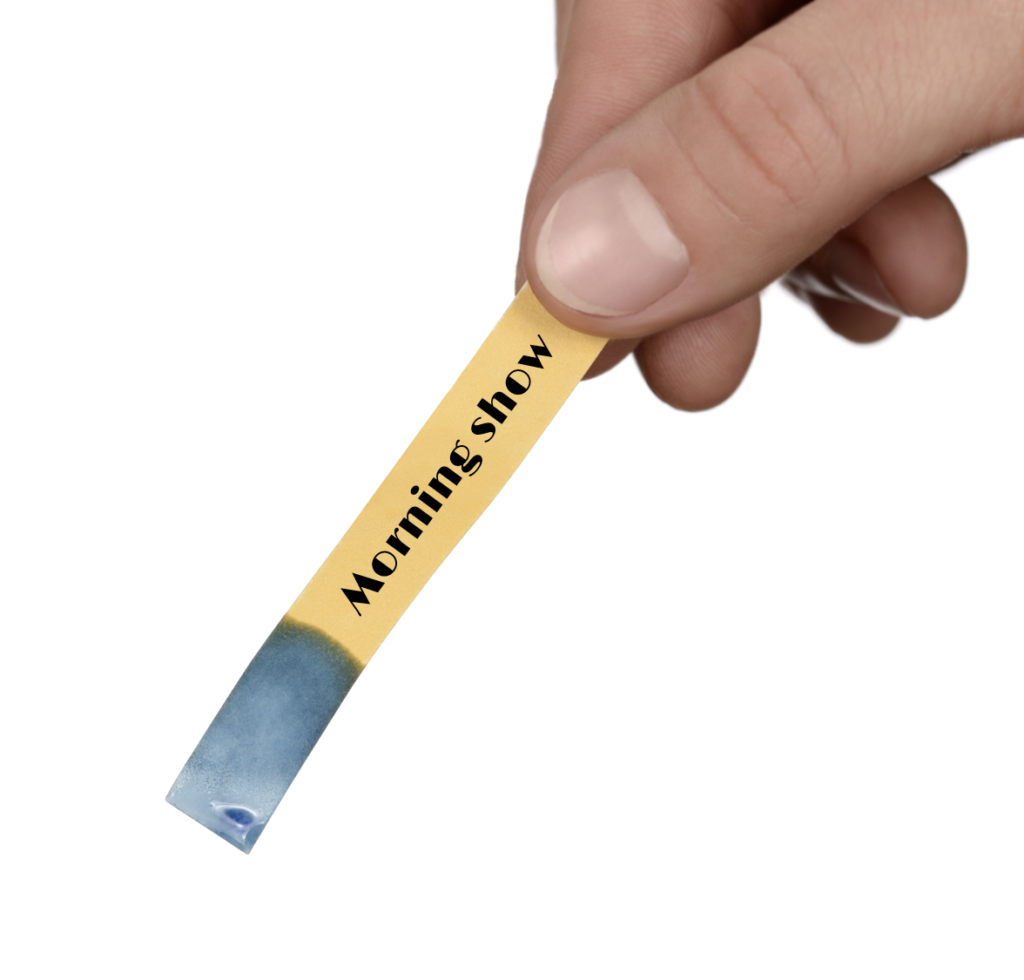 nuances of appeal – why choose your radio station versus all the others entertainment sources?
nuances of appeal – why choose your radio station versus all the others entertainment sources?
Are you a music station without much in the way of talent?
Are you a station with personalities but little else?
Or is your station a successful mashup of music, personalities, and other brand strengths that allows you to grow, evolve, and adapt – whether there’s a pandemic, a hurricane, a school shooting, a local team in the playoffs, or a big tech company decides to build its new headquarters in your metro?
Howard Stern made some lasting contributions to broadcast radio today, 15 years after getting out of Dodge. Yes, his style, demeanor, and humor have been much copied. But one of his many legacies is to help us better understand the formula that drives radio station success in any decade.
Its Brand DNA.
When you learn that, anything’s possible.
- Media And Technology In 2025: Believe It Or Not! - April 18, 2025
- In Radio, You Just Never Know - April 17, 2025
- The Secret To Making A Great Podcast (And Great Radio) - April 16, 2025




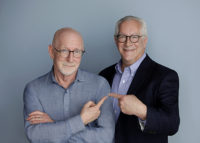
20 years ago I was saying that radio needs to get back to the personality style it had in the 60. Give them a reason to tune in to your station because they can get their music from anywhere.
Keep it live and local is the best way to compete with the other music outlets because you are giving the listeners something on your station they can’t get from XM.
I’ve been rolling my eyes since the ’60s about this! The personality DJ shared exploring the sales charts with us. It’s a completely different experience than streaming Muzak,
Sure is. Thanks for the comment, Bob.
Carter, thanks for connecting on this. I agree with your first paragraph 100%.
But have you listened to the music channels lately on SiriusXM? The personality presence is bigger and better. And while they may not be local, jocks like Kristine Stone, Sluggo, Meg Griffin, Jim Ladd, Earl Bailey, and the old MTV VJs on the 80s channel are sounding good – warm, personal, connected. And the use of stars like Tom Petty, Little Steven, Peter Asher, and several others is nicely done. I am now using them to motivate commercial radio stations to step it up.
Fred, I subscribed to XM years ago. but after the merger, the playlists got very tight and compression on the channels made the music sound terrible and cancelled.
What you said proves my point in a way. XM has stepped up and gotten personalities for their music channels and that makes for some compelling listening. They saw what the service was lacking and fixed it.
That also dovetails back into my point. For local radio to remain relevant, they have to be local with the local, irresistable personalities.
People you want to listen to talking about what’s going on in your town. That’s captivating programming right there.
I wish you success in convincing commercial stations to get with the program.
Fred, it’s the reason why I am glued every morning to the Bob & Tom Show. Even though Bob retired in 2015 the show has continued very successfully with new cast members. Kidd Kraddick died eight years ago and yet his show continues with his name on it, very successfully with six key cast members. It’s hard to stop I will oiled machine. Bob & Tom is televised with seven HD Cameras, switched LIVE! It’s actually become a funny and wildly entertaining TV show every morning that happens to be also on the radio, and is appointment listening for me and thousands of others. I think it’s the way of the future, and I say that not just because I began videotaping DJ’s some 42 years ago either.
Wow, Art, was just checking out your Jacor Years video on the “Nation’s Station,” WLW. That was fantastic! Funny you have that picture with Shotgun at the top of your page. Shotgun’s my “Who doesn’t want to do what HE’S doing” inspiration for getting into radio. And I don’t know need to tell you in addition to his incredible talent, he may also be the nicest person to ever work in radio. (Besides Fred.) Looking forward to looking at more of your videos. Thanks for sharing them with all us radio geeks and freaks!
No doubt about it, Art. Video of DJs is your claim to fame, and you correctly intuited what’s most important, powerful, and “sticky” about radio – the personalities. And I couldn’t agree more about the Bob & Tom evolution (same with thee Kraddick show). A lot of work went into keeping these shows vital, and it has worked. Thanks for what you do for radio & happy holidays.